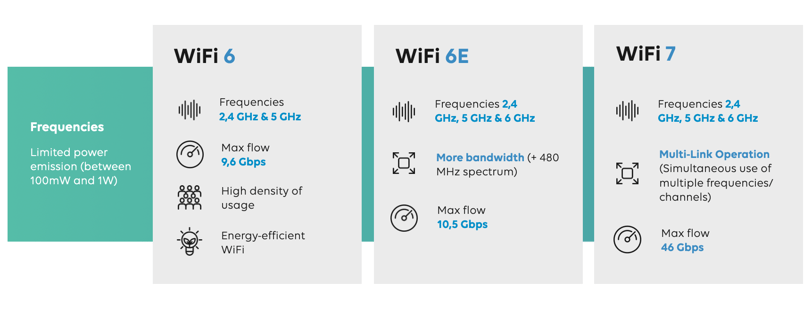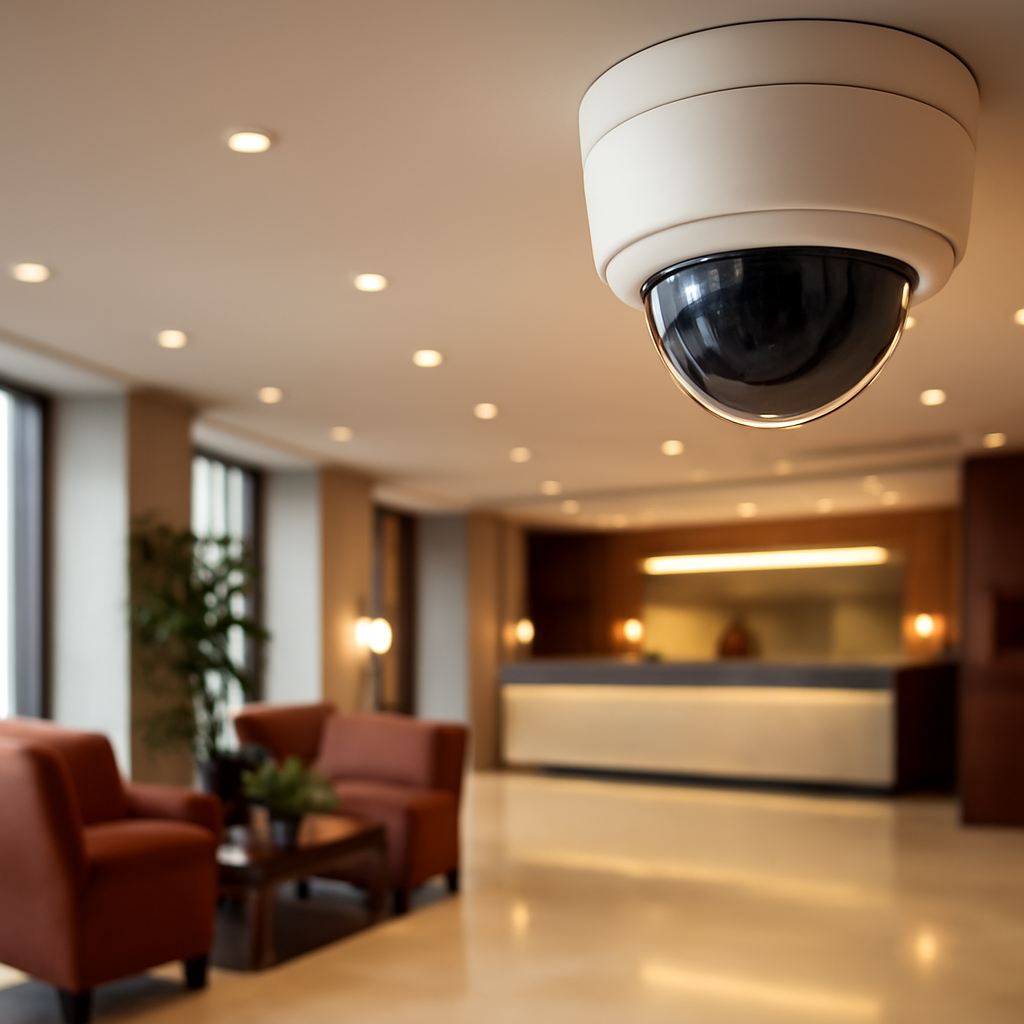
While WiFi 6 and WiFi 6E are now firmly established in the market, WiFi 7 (802.11be) has officially arrived, with the first compatible equipment rolling out since 2024. This evolution is a significant step forward in wireless connectivity—but what does it really mean for professionals?
What is WiFi 7?
WiFi 7 is the next generation of wireless connectivity, succeeding WiFi 6 and WiFi 6E. It stands out thanks to:
- 320 MHz channels, doubling the channel width of WiFi 6E.
- 4096-QAM modulation, improving spectral efficiency and throughput.
- Multi-Link Operation (MLO), enabling simultaneous use of multiple frequency bands for better stability.
- Lower latency and optimized interference management, ideal for intensive uses such as VR, cloud gaming, or critical industrial applications.
What are the concrete benefits of WiFi 7?
1. Higher theoretical speeds
WiFi 7 can reach theoretical speeds of up to 46 Gbps, nearly 4.8× faster than WiFi 6. In real-world conditions, these speeds are achievable only in optimal environments (few obstacles, close to the AP, low interference).

2. Better handling of dense environments
Thanks to new modulation capabilities and the simultaneous use of multiple bands, WiFi 7 is particularly effective in high-traffic spaces (offices, hotels, campuses, venues). It reduces congestion and improves user experience.
3. Lower latency for critical applications
Optimized band management and technologies like MLO enable a significant reduction in latency—a key asset for businesses relying on HD videoconferencing, cloud computing, or teleoperation.
4. More stable and reliable connectivity
By combining multiple frequency bands simultaneously, WiFi 7 offers greater resilience to interference and congestion, ensuring a more reliable connection—even in complex environments.
5. Security advances
With the adoption of WPA3 and improvements in handling simultaneous connections, WiFi 7 offers stronger protection against network attacks—crucial for companies subject to strict regulatory constraints (ISO 27001).

6. Energy impact to watch
Although WiFi 7 optimizes device-side power consumption, operating stronger WiFi networks means increased infrastructure consumption (APs, routers). WiFi 7 access points consume more electricity than previous generations, which must be considered for energy efficiency.
7. Gradual, strategic adoption
The first WiFi 7 devices are available today, but adoption remains gradual—deployment will occur in stages and take time to become ubiquitous. As with previous generations, high-end devices such as the latest smartphones, laptops, and tablets are first to integrate the standard.
These devices, often featuring the latest innovations, are designed to fully exploit WiFi 7’s capabilities—higher throughput and lower latency. This initial integration in premium devices is a crucial step before broader democratization.
Over time, as production costs fall and the technology matures, WiFi 7 will be integrated into a wider range of devices, including mid-range and entry-level models, enabling more users to benefit. This progressive transition is typical of technology adoption cycles.
➡️ So, should you switch to WiFi 7 today?
WiFi 7 delivers revolutionary theoretical gains—but only under exceptional conditions: direct line-of-sight to the AP (no walls between user and access point) and minimal interference. In residential scenarios, for example, placing APs in hallways prevents the use of the very high modulations enabled by WiFi 7.
Another example: in real life, two spatial streams are usually plenty. This is even truer on mobile devices because adding streams means more antennas and RF chains—adding cost, space, and power consumption. To conclude with Pirelli’s famous slogan, "Power is nothing without control": choose your network operator wisely, because beyond the standard, the expertise of the team deploying and operating the infrastructure determines the service quality.
While WiFi 7 brings innovations, the real-world gains depend on installation conditions and use cases. Choosing the right standard ultimately means choosing the right operator to ensure an optimized deployment tailored to users’ needs.
❓ What is the maximum speed of WiFi 7?
WiFi 7 can reach a theoretical 46 Gbps, but in practice it depends on factors like network congestion, obstacles, and the equipment used.
❓ Is WiFi 7 compatible with previous WiFi generations?
Yes. WiFi 7 is backward compatible with WiFi 6, WiFi 5, and WiFi 4. To get maximum performance, both devices and APs must support the standard.
❓ Which devices support WiFi 7?
Early compatible gear appeared in 2024—high-end routers and some premium smartphones and laptops. Broad adoption will take a few years.
❓ Is WiFi 7 useful for businesses?
It depends on the needs. In high-density environments (offices, hotels, stadiums, industry), WiFi 7 can bring real advantages in throughput, latency, and stability.
❓ Should you wait for WiFi 7 to refresh your infrastructure?
Not necessarily. WiFi 6E already delivers excellent performance for most organizations. Assess your needs before opting for a WiFi 7 rollout.
❓ Does WiFi 7 consume more energy?
Yes—wider channels and higher-power APs increase energy draw. Consider this for both economic and environmental reasons.
❓ What are the main challenges of WiFi 7?
- Equipment cost: Compatible routers and APs remain expensive.
- Energy consumption: More powerful networks demand more energy.
- Client refresh: To fully benefit, user devices must be compatible.
We hope this FAQ answers the key questions about WiFi 7. Feel free to contact us for support with your connectivity strategy.


